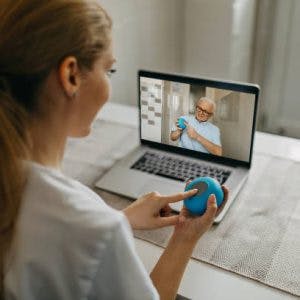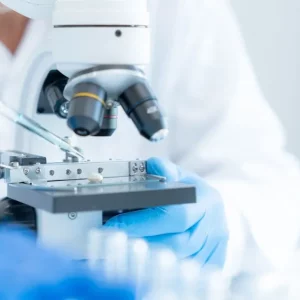Hyperbaric oxygen therapy for stroke patients may help recover movement, improve memory, and address other secondary effects of stroke. Although this treatment is not necessarily a new concept, research on hyperbaric oxygen therapy for stroke patients is gaining ground.
Each individual is different, and every stroke is different, so your recovery will be unique to you and may require a combination of treatments. Hyperbaric oxygen therapy is an example of this as it can be used in conjunction with rehabilitative exercise and other methods. In this article we will discuss how hyperbaric oxygen therapy works, the effects it can have on brain function, and what individuals may benefit from this treatment.
What Is Hyperbaric Oxygen Therapy?
Hyperbaric oxygen therapy (HBOT) is a non-invasive treatment method that involves breathing pure oxygen in a pressurized environment. This is performed in a hyperbaric oxygen chamber where the pressure of the air around you is increased, which allows your body to take in an increased amount of oxygen.
Hyperbaric oxygen therapy generally takes around 2 hours and can be administered in a clear chamber or in a room designed to accommodate multiple patients. When an individual is placed in a hyperbaric oxygen chamber, the air consists of 100% oxygen versus the 21% oxygen of our normal air intake. This promotes tissue healing from a variety of conditions including stroke, which we will discuss next.
How Does Oxygen Therapy Help Stroke Recovery?
When an individual experiences a stroke, this can be ischemic or hemorrhagic in nature. An ischemic stroke occurs when an artery in the brain is obstructed by a clot whereas a hemorrhagic stroke occurs when a blood vessel bursts. Both types of stroke cause oxygen deprivation and tissue death within the brain and can lead to a wide array of secondary effects.
Hyperbaric oxygen therapy increases the amount of oxygen collected by the lungs, which in turn increases the amount of available oxygen in body tissue. This includes tissue in the brain, increasing the amount of oxygen available to brain cells.
Following a stroke, the brain is able to heal itself through a process called neuroplasticity. Neuroplasticity allows surrounding parts of the brain take over the responsibility of the damaged part of the brain by building new connections between brain cells. When the brain is busy rebuilding connections through the process of neuroplasticity, it requires even more oxygen.
The brain consumes 20% of the body’s oxygen, but that is only enough to operate a small percentage of brain cells at any given point in time. Hyperbaric oxygen therapy for stroke patients provides extra oxygen to the brain, essentially working as ‘brain food’ to speed up the process of neuroplasticity.
Hyperbaric Oxygen Therapy and Stroke Exercise
To trigger the rewiring process, you need to stimulate the brain through massed practice of rehab exercises. For example, if you need to regain leg movement, you’ll need to maximize neuroplasticity by practicing leg movements over and over. Repetitive practice is the essential ingredient for recovery after stroke.
After your stroke, your rehab team will help you develop a plan to address your own specific goals to improve your function and independence. This generally consists of stroke exercises to improve range of motion, strength, walking, and performance of daily activities. While repetitive practice is the primary driver of neuroplasticity, hyperbaric oxygen therapy can play a secondary role by speeding up the process.
Increased oxygen availability in the brain can optimize healing and regeneration of neural connections. This means survivors may make faster gains in functional movement due to this increased neuron activity.
There’s no escaping the hard work of rehab, but hyperbaric oxygen therapy can provide a potentially powerful boost for stroke patients. Next, let’s discuss the specific secondary effects of stroke that can be positively impacted by hyperbaric oxygen therapy.
What Stroke Effects Does Oxygen Therapy Treat?
Hyperbaric oxygen therapy has been proven to address several secondary effects commonly experienced by stroke patients. For example, HBOT can lead to a significant increase in cognitive function, even in the later stages of stroke recovery. Hyperbaric oxygen therapy is also currently being used to improve movement after stroke, even for survivors experiencing post-stroke paralysis.
Other reported benefits of hyperbaric oxygen therapy for stroke survivors include decreased tissue inflammation, reduced neural cell death, and improvement in language abilities. Furthermore, hyperbaric oxygen therapy may be a promising treatment for chronic pain after stroke, which affects a large number of survivors.
Stroke survivors can try HBOT at any stage in their stroke recovery timeline, whether your stroke was a few months or many years ago. Although most studies have been conducted in the early stages of stroke recovery, Dr. Shai Efrati has published research that supports hyperbaric oxygen therapy for stroke patients in the chronic stage.
In his research, Dr. Efrati has found elevated brain activity, improved daily function, and increased quality of life to be correlated with hyperbaric oxygen therapy. This implies that HBOT may be used to boost neuroplasticity in the later stages of stroke rehabilitation.
Potential Drawbacks of Oxygen Therapy for Stroke
Although hyperbaric oxygen therapy is not a new treatment, research remains limited and study results are mixed. For example, one study researched the effects of hyperbaric oxygen therapy for patients experiencing an acute ischemic stroke. They found no benefit from HBOT in this study group and suggested this treatment may even be harmful for this population.
A systematic review from 2005 suggested there is insufficient evidence to determine the effectiveness of hyperbaric oxygen therapy for stroke patients. Similarly, a review performed in 2015 by the American Heart Association concluded that hyperbaric oxygen therapy remains an experimental treatment for acute ischemic stroke.
In addition to limited research, there are also potential side effects of hyperbaric oxygen therapy. In some cases, HBOT can cause lightheadedness, fatigue, injury to the sinuses or inner ear, and temporary vision changes. In more extreme cases, lung issues and oxygen toxicity can occur.
Hyperbaric Oxygen Therapy for Stroke: Summary
When a stroke occurs, the brain is deprived of the oxygen it needs for normal function, leading to tissue damage. This leads to a wide array of secondary effects and requires extensive rehabilitation for most survivors. This rehabilitation generally consists of a variety of treatment techniques depending on the survivor’s unique needs.
Hyperbaric oxygen therapy is a treatment that provides a patient with 100% oxygen in a pressurized environment. By increasing the amount of oxygen available to brain cells, this can facilitate healing and neuroplasticity. Combined with repetitive exercise, hyperbaric oxygen therapy can potentially boost recovery and promote the return of both physical and cognitive function.
Hyperbaric oxygen therapy for stroke patients is still considered experimental. It is important to talk with your doctor to determine if you are an appropriate candidate for this treatment. Additionally, they can give you the green light to search for clinical trials in your area.
Hyperbaric oxygen therapy may be a beneficial addition to a stroke recovery program. Keep in mind, however, that repetitive rehab exercise and consistency are the keys to recovery from stroke. Stay dedicated to your rehabilitation program and continue to work closely with your rehab team to reach your recovery goals.















